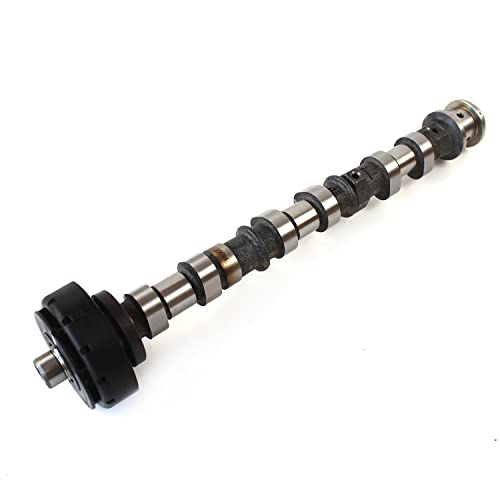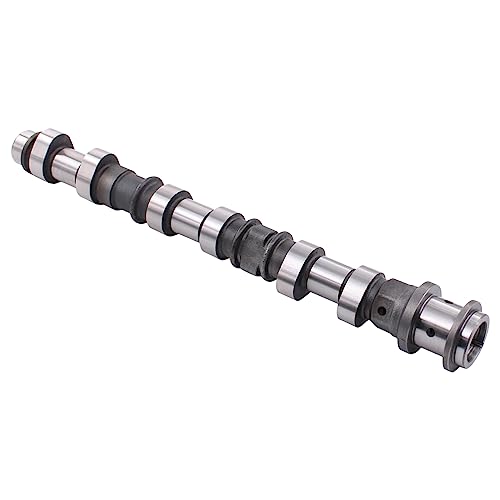Ever wondered about that mysterious component under your car’s hood that helps create the powerful roar of your engine? The camshaft is one of the unsung heroes of your vehicle’s performance, quietly orchestrating the precise dance of valves that keeps your engine running smoothly.
We’ll take you through everything you need to know about this crucial engine component. From how it controls the timing of valve openings to its direct impact on your vehicle’s power output and fuel efficiency, understanding your camshaft can help you make better maintenance decisions and even unlock hidden performance potential in your engine.
What Is a Camshaft and Where Is It Located
A camshaft is a rotating cylindrical shaft with egg-shaped lobes (cams) that convert rotational motion into linear motion to operate the engine’s valves. These precision-engineered shafts feature carefully designed lobes that push against valve lifters or rockers as the shaft rotates. The camshaft’s lobe profile determines critical valve timing parameters including when valves open, how long they stay open, and how far they open.
Most modern passenger vehicles use overhead camshaft designs where the camshaft is positioned above the cylinder head, directly actuating the valves. This configuration, known as OHC (Overhead Camshaft), offers improved efficiency and performance over older pushrod designs. Performance engines often employ DOHC (Dual Overhead Camshaft) systems with separate camshafts for intake and exhaust valves, allowing for optimized valve timing on both sides.
In older or some current truck engines, the camshaft sits within the engine block. These pushrod engines use long metal rods to transfer the camshaft’s motion up to the valves. While this design creates more moving parts, it allows for a more compact engine height and sometimes simpler maintenance.
The camshaft connects to the crankshaft through timing chains, belts, or gears and rotates at precisely half the speed of the crankshaft in four-stroke engines. This synchronized relationship ensures valves open and close at the exact right moment during each piston’s cycle, maintaining the proper sequence of intake, compression, power, and exhaust strokes.
The Basic Function of a Camshaft in an Engine

A camshaft serves as a critical component in internal combustion engines, converting rotational motion into reciprocating motion through its distinctive lobed design. This shaft features a row of pointed cams or lobes that push against valves as it rotates, creating the mechanical action necessary for engine operation. During rotation, these lobes open and close the engine’s intake and exhaust valves, allowing air-fuel mixture to enter combustion chambers and exhaust gases to exit.
How Camshafts Control Valve Timing
Camshafts control valve timing through their precisely engineered lobe profiles and synchronization with the crankshaft. The exact shape and positioning of each lobe on the camshaft dictates exactly when valves open and close during the engine cycle. Connected to the crankshaft via a timing belt or chain, the camshaft typically rotates at half the crankshaft’s speed, maintaining perfect coordination between valve operations and piston movement. This synchronized relationship ensures that air and fuel enter cylinders and exhaust gases exit at optimal moments for combustion efficiency.
The Relationship Between Camshafts and Engine Performance
Camshaft design directly impacts horsepower, torque, and emissions in every internal combustion engine. The camshaft’s valve control and timing capabilities are fundamental to the four-stroke cycle—intake, compression, power, and exhaust—which determines an engine’s efficiency and performance characteristics. Engineers develop camshaft profiles to match exact performance goals, balancing factors like power delivery, fuel economy, and emissions compliance. Performance enthusiasts often upgrade camshafts to enhance engine output, though such modifications require careful consideration of related components including rocker arms, valvetrain parts, and fuel management systems to maintain reliability. Without proper camshaft function, an engine simply can’t deliver optimal performance regardless of other enhancements.
Different Types of Camshafts

Camshafts come in several distinct designs, each with unique characteristics that affect engine performance, efficiency, and maintenance requirements. Let’s explore the main types of camshafts used in modern and traditional internal combustion engines.
Overhead Camshafts vs. Pushrod Designs
Overhead camshaft (OHC) systems position the camshaft directly above the cylinders for more precise valve control. Single overhead cam (SOHC) designs use one camshaft to operate both intake and exhaust valves, while dual overhead cam (DOHC) configurations employ separate camshafts for intake and exhaust valves, allowing for more refined valve timing and potentially higher performance. These overhead designs create a more direct connection to the valves, reducing moving parts and potential points of failure.
Pushrod designs, in contrast, locate the camshaft within the engine block, operating valves through a system of lifters, pushrods, and rocker arms. This traditional configuration appears in many classic engines and some modern V8s, offering a compact engine height and simplified maintenance access. The additional components in the valve train can create more mechanical complexity, but many manufacturers have refined these systems to deliver reliable performance in exact applications.
Variable Valve Timing Camshafts
Variable valve timing (VVT) camshafts represent a important advancement in engine technology, dynamically adjusting valve operation based on engine conditions. These sophisticated systems use hydraulic or electronic actuators to modify the camshaft’s phase relative to the crankshaft, optimizing performance across different RPM ranges and load conditions. VVT technology allows engines to deliver better low-end torque while maintaining high-end power, improving fuel efficiency and reducing emissions.
Advanced VVT systems can adjust not only valve timing but also lift and duration, creating an engine that effectively changes its personality based on driving conditions. These adaptable camshaft designs have become increasingly common in modern vehicles as manufacturers seek to balance performance demands with stringent emissions regulations. The ability to precisely control when and how valves open transforms what was once a fixed mechanical component into a ever-changing system that responds to real-time engine needs.
Common Camshaft Problems and Symptoms

Camshaft issues can significantly impact engine performance and longevity. Worn or damaged camshafts often lead to a cascade of engine problems that require prompt attention to prevent costly repairs.
Signs of a Failing Camshaft
Engine misfires frequently indicate camshaft problems, occurring when valves don’t open and close at the proper times. Poor engine performance, including reduced power, decreased fuel efficiency, and sluggish acceleration, points to potential camshaft failure. Unusual noises such as tapping, clattering, or grinding from the engine area typically suggest worn cam lobes, damaged lifters, or other camshaft-related components. Modern vehicles will activate the check engine light when the onboard computer detects issues with camshaft timing or performance. Hydraulic lifters or followers that ride on cam lobes can wear out, producing distinct tapping sounds that are especially noticeable when the engine is cold. Bent or damaged camshafts cause improper valve timing, resulting in misfires and potentially causing extensive engine damage if not addressed promptly.
Maintenance Tips for Prolonging Camshaft Life
Regular oil changes serve as the foundation of camshaft maintenance, ensuring proper lubrication of this critical component. High-quality oil matching manufacturer specifications provides optimal protection against wear on camshaft lobes and lifters. Avoiding extreme temperature conditions helps reduce thermal stress on the camshaft and related components. Monitoring engine performance allows for early detection of potential issues before they escalate into major problems. Following the manufacturer’s recommended maintenance schedule ensures all engine components, including the camshaft, receive appropriate inspection and service at optimal intervals. Addressing timing issues immediately prevents poor engine performance and increased emissions that result from improper camshaft-to-crankshaft synchronization. Listening for unusual engine sounds during startup can help identify potential camshaft problems in their early stages, saving important repair costs.
Performance Upgrades and Aftermarket Camshafts

Aftermarket camshafts represent one of the most effective ways to enhance engine performance through precise valve timing modifications. These specialized components can dramatically transform how an engine breathes and performs across different RPM ranges.
How Camshaft Modifications Affect Engine Power
Camshaft modifications directly influence an engine’s power output by altering three critical aspects: valve lift, duration, and timing. Performance camshafts typically feature more aggressive lobe profiles that keep valves open longer and lift them higher, allowing more air-fuel mixture into the combustion chambers. These design changes can significantly increase horsepower, particularly at higher RPMs where racing and performance applications benefit most. Many aftermarket camshafts optimize valve overlap—the period when both intake and exhaust valves are simultaneously open—creating a scavenging effect that improves cylinder filling efficiency. The exact lobe design determines where in the RPM range the engine will develop peak power, with some configurations favoring low-end torque while others maximize top-end horsepower. Performance enthusiasts must carefully select camshaft specifications that match their driving goals, as modifications that increase high-RPM power often sacrifice low-speed drivability and fuel economy.
Modifications
Aftermarket camshafts come with various modifications designed to enhance exact performance characteristics. Lobe design alterations change the shape and size of the camshaft’s lobes, affecting valve timing patterns to achieve particular power delivery goals. Engineers adjust the lift and duration parameters to control how far valves open and how long they remain open during each cycle. High-performance applications often use increased lift to maximize airflow into the combustion chamber, while extended duration keeps valves open longer to support higher RPM operation. Modern dual overhead cam (DOHC) configurations allow for more precise valve control compared to single cam designs, enabling complex camshaft profiles that optimize both intake and exhaust flow independently. These modifications must be carefully balanced to maintain proper engine operation, as excessive valve overlap can reduce vacuum and affect idle quality. Performance camshafts frequently incorporate advanced materials and manufacturing techniques to withstand the increased stress from higher valve spring pressures and engine speeds.
Configurations
The physical arrangement of camshafts within an engine significantly impacts performance potential and upgrade options. DOHC engines use separate camshafts for intake and exhaust valves, offering greater flexibility for performance tuning compared to single overhead cam designs. This configuration allows performance camshafts to optimize valve timing events independently for each valve train, resulting in more precise control over the combustion process. Variable valve timing systems add another dimension to camshaft performance, with some aftermarket upgrades designed to work with or enhance these factory systems. Performance camshafts for DOHC applications often feature asymmetric lobe profiles that apply different timing strategies to intake and exhaust valves, maximizing both power and efficiency. Racing-oriented configurations may employ radical cam profiles with extremely high lift and duration values that wouldn’t be practical for street use due to rough idle qualities and poor low-speed response. When selecting aftermarket camshafts, compatibility with existing engine components like valve springs, lifters, and rockers must be carefully considered to ensure reliable operation.
Conclusion
The camshaft stands as the unsung hero of your engine’s performance maintaining the critical rhythm that keeps your car running smoothly. Understanding this vital component helps us make better maintenance decisions and recognize potential issues before they become expensive problems.
Whether you’re seeking better fuel economy or maximum horsepower upgrading your camshaft can be a game-changer when done properly. Remember that regular maintenance including timely oil changes is essential for preserving your camshaft’s functionality.
By listening to your engine and addressing unusual sounds or performance issues promptly you’ll extend not just your camshaft’s life but your entire engine’s longevity. Your camshaft may be hidden inside your engine but its impact on your driving experience is undeniable.
Frequently Asked Questions
What is a camshaft and why is it important in a car engine?
A camshaft is a rotating cylindrical shaft with egg-shaped lobes that converts rotational motion into linear motion to operate the engine’s valves. It’s crucial because it controls the timing of valve openings, directly affecting power output and fuel efficiency. Without proper camshaft function, an engine cannot achieve optimal performance regardless of other enhancements.
How does a camshaft affect engine performance?
The camshaft directly impacts horsepower, torque, and emissions through precise valve timing. Its lobe shape and positioning determine when and how long valves stay open, affecting combustion efficiency. Engineers develop specific camshaft profiles to meet performance goals, balancing power delivery, fuel economy, and emissions compliance.
What are the different types of camshaft designs?
Modern vehicles commonly use Overhead Camshaft (OHC) and Dual Overhead Camshaft (DOHC) systems for improved efficiency and performance. Older vehicles may have pushrod designs with the camshaft located in the engine block. DOHC systems allow independent optimization of intake and exhaust valve timing, while variable valve timing systems enhance overall performance.
What are common symptoms of a failing camshaft?
Signs of camshaft problems include engine misfires, poor performance, unusual noises (particularly ticking or knocking sounds), and an illuminated check engine light. You might also notice reduced power, decreased fuel efficiency, or rough idling. Addressing these symptoms promptly can prevent more extensive and costly engine damage.
How can I maintain my camshaft for longer life?
Maintain your camshaft by changing oil regularly with the manufacturer-recommended type, avoiding extreme temperature operation, monitoring engine performance, and following the maintenance schedule. Check timing components periodically, listen for unusual sounds, and address any performance issues immediately. Proper maintenance prevents premature wear and expensive repairs.
Can I upgrade my camshaft for better performance?
Yes, aftermarket performance camshafts can enhance engine output through more aggressive lobe profiles that improve airflow and increase horsepower. However, choose specifications that match your driving goals, as modifications can impact low-speed drivability and fuel economy. Consider that installation may require additional component upgrades and professional installation for optimal results.
How does the camshaft work with the crankshaft?
The camshaft operates in synchronized timing with the crankshaft, typically rotating at half the crankshaft’s speed in four-stroke engines. This precise synchronization ensures valves open and close at the correct moments during the engine cycle. Timing belts, chains, or gears maintain this relationship, and proper timing is critical for engine operation.
What’s the difference between OHC and DOHC engines?
An Overhead Camshaft (OHC) engine has one camshaft controlling both intake and exhaust valves. A Dual Overhead Camshaft (DOHC) engine features separate camshafts for intake and exhaust valves, allowing for more precise valve control and typically better performance. DOHC designs generally permit higher RPM operation and improved breathing, resulting in increased power output.













